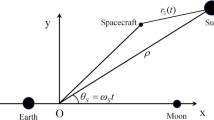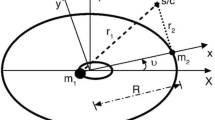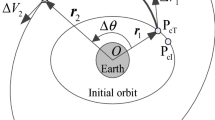Abstract
This paper discusses the problem of design and optimization of low-energy transfer orbit with multi-body environment. A new integrative method is proposed to effectively solve the problem, in which the parameterized patched manifolds in CR3BP (circular restricted three-body problems), the shape-based method with multi-body environment, the homotopic method with multi- body environment, and the low-thrust capturing and descending algorithm with multi-body environment are all included. Firstly, the parameters describing the patched manifolds in CR3BP are optimized until the least total absolute velocity increment has been got, including the employment of the shape-based method with multi-body environment. Secondly, the low-thrust control laws of the transfer orbit are optimized employing the homotopic method with multi-body environment that transfers the fuel optimization problem to an easier energy optimization problem. Thirdly, the low-thrust descending orbit around Mars is computed using the laws proposed in this paper. As a typical example, the Earth-Mars transfer orbit design is discussed. The results showed that the parameters describing the patched manifolds could be optimized by the DE (differential evolution) algorithm effectively; the homotopic method with multi-body environment could get the optimal value that meets the first order optimality conditions; and the low-thrust descending orbit could effectively be captured by Mars and finally become a circular parking orbit around it by the hypothesis control laws proposed in this paper. It shows that the final fuel cost is much less than the optimal transfer in the patched two-body problems. In conclusion, the method proposed in this paper could effectively solve the low-energy low-thrust optimal control problem in multi-body environment for the future deep space explorations.
Similar content being viewed by others
References
Gomez G, Koon W S, Lo M W, et al. Invariant manifolds, the spatial three-body problem and space mission design. In: Astro-dynamics Specialist Meeting, Quebec City: AIAA/AAS, Canada, 2001
Xu M, Tan T, Xu S J. Research on the transfers to Halo orbits from the view of invariant manifolds. Sci China Tech Sci, 2012, 55: 671–683
Wang S, Shang H B, Wu W R, Interplanetary transfers employing invariant manifolds and gravity assist between periodic orbits. Sci China Tech Sci, 2013; 56: 786–794
Gomez G, Koon W S, Lo M W, et al. Connecting orbits and invariant manifolds in the spatial restricted three-body problem. Nonlinearity, 2004; 17: 157–1606
Koon W S, Lo M W, Marsden J E, et al. Constructing a low energy transfer between jovian moons. Contem Math, 2002. 292: 129–145
Lo M W. The interplanetary superhighway and the origins program. In: IEEE Aerospace Conference, MT: Big Sky, 2002
Yamato H, Spencer D B. Orbit transfer via tube jum** in planar restricted problems of four bodies. J Spacecraft Rockets, 2005. 42: 321–328
Gomez G, Koon W S, Lo M W, et al. Invariant manifolds, the spatial three-body problem and space mission design. In: Astrodynamics Specialist Meeting, Quebec City, Canada, 2001
Wang Y M, Cui P Y, Qiao D. Opportunities search of transfer between interplanetary halo orbits in ephemeris model. Sci China Tech Sci, 2014; 56: 188–193
Anil V R, David A B, Christopher D, et al. GPOPS, A MATLAB software for solving multiple-phase optimal control problems using the gauss pseudospectral method. ACM T Math Software, 2010; 37: 22–39
Lin K P, Luo Y Z, Zhang J, et al. Planning for space station long-duration orbital mission under multi-constraints. Sci China Tech Sci, 2014; 56: 1075–1085
Li H N, Gao Z Z, Li J S, et al. Mathematical prototypes for collocating geostationary satellites. Sci China Tech Sci, 2014; 56: 1086–1092
Betts J T, Huffman W P. Mesh refinement in direct transcription methods for optimal control. Optim Control Appl Methods, 1998; 19: 1–21
Christopher L D, William W H, Anil V R. An hp-adaptive pseudospectral method for solving optimal control problem. Optim Control Appl Methods, 2011; 32: 476–502
Huang G Q, Liu Y P, Nan Y, et al. Multi-goals global optimization for low-thrust deep space probe orbit. J Syst Eng Electron, 2008; 34: 1653–1659
Jiang F H, Chen Y, Liu Y C, et al. The solutions of tsinghua university for the global trajectory optimization competition in 2010 (in Chinese). Mech Pr, 2010; 3: 103–105
Kluever C A. Optimal low-thrust interplanetary trajectories by direct method techniques. J Astronaut Sci, 1997; 45: 247–262
Li J F, Jiang F H. The review of optimization method for ccontinuous low-thrust spacecraft explorations (in Chinese). Mech Pr, 2011; 23: 1–6
Guo T D, Jiang F H, Baoyin H X, et al. Fuel optimal low thrust rendezvous with outer planets via gravity assist. Sci China Phys Mech Astron, 2011; 54: 756–769
Edelbaum T N. Propulsion requirements for controllable satellites. J Am Rock Soc, 1961; 31: 1079–1089
Betts J T. Very low-thrust trajectory optimization using a direct SQP method. J Comput Appl Math, 2000; 120: 27–40
Gao Y. Near-optimal very-low-thrust earth-orbit transfers and guidance schemes. J Guid Control Dynam, 2007; 30: 529–539
Lisa A H. Optimal transfers between libration point orbits in the elliptic restricted three-body problem. Dissertation of Doctor Degree. West Lafayette: Purdue University, 1992
Liu L, Wang X. Orbital Mechanics of the Lunar Probe. Bei**g: National Defense Industry Press, 2006. 127–139
Wang S K, Martin W L, Jerrold E M, et al. Dynamical Systems, the Three-Body Problem and Space Mission Design. Marsden Books. 2010, 151–160
Robert T, Patrick A W. The Geometry of Halo orbits in the restricted three body problem. Dissertation of Doctor Degree. Minnesota: University of Minnesota, 1996
Chen Y, Baoyin H X, Li J F. Trajectory design for the Moon departure libration point mission in full ephemeris model. Sci China Tech Sci, 2011; 54: 2924–2934
Roby S W. A design tool for constructing multiple lunar swingby trajectories. Dissertation of Master Degree. West Lafayette: Purdue University, 1993. 123–136
Howard D C. Orbital Mechanics for Engineering Students. Elsevier, 2005, 163–172
Luo Y Z, Yang Z, Li H N. Robust optimization of nonlinear impulsive rendezvous with uncertainty. Sci China-Phys Mech Astron, 2014; 57: 731–740
Bradley J W. Shape-based approximation method for low-thrust trajectory optimization. In: Astrodynamics Specialist Conference and Exhibit. Hawaii: AIAA, 2008. 18–21
Chen Y, Zhao G Q, Baoyin H X, et al. Orbit design for mars exploration by the accurate dynamic model (in Chinese). China Space Sci Tech, 2011; 2: 8–15
Li H N. Orbit Determination for Maneuvering Satellite. Bei**g: National Defense Industry Press, 2013. 98–99
Jiang F H, Baoyin H X, Li J F. Practical techniques for low-thrust trajectory optimization with homotopic approach. J Guid Control Dynam, 2012; 35: 245–258
Frank E L, James M L. Low-thrust trajectories for human missions to Ceres. Acta Astronaut, 2014; 95: 124–132
Falck R, Gefert L. A Method of efficient inclination changes for low-thrust spacecraft. In: Astrodynamics Specialist Conference and Exhibit, California: AIAA, 2002, 5–8
Author information
Authors and Affiliations
Corresponding author
Rights and permissions
About this article
Cite this article
Lu, Y., Li, H., Li, J. et al. Design and optimization of low-energy transfer orbit to Mars with multi-body environment. Sci. China Technol. Sci. 58, 1660–1671 (2015). https://doi.org/10.1007/s11431-015-5847-7
Received:
Accepted:
Published:
Issue Date:
DOI: https://doi.org/10.1007/s11431-015-5847-7




